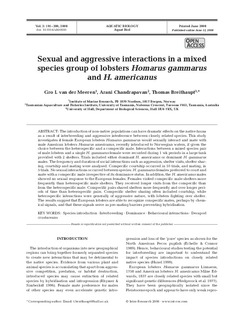| dc.description.abstract | The introduction of non-native populations can have dramatic effects on the native fauna as a result of interbreeding and aggressive interference between closely related species. This study investigates if female European lobsters Homarus gammarus would sexually interact and mate with male American lobsters Homarus americanus, recently introduced to Norwegian waters, if given the choice between the heterospecific and a conspecific male. Interactions between a mixed species pair of male lobsters and a single H. gammarus female were recorded during 1 wk periods in a large tank provided with 2 shelters. Trials included either dominant H. americanus or dominant H. gammarus males. The frequency and duration of social interactions such as aggression, shelter visits, shelter sharing, courtship and mating were analysed. Conspecific courtship occurred in 10 trials, and mating, in 5 trials. No sexual interactions occurred between species. H. gammarus females preferred to court and mate with a conspecific male irrespective of its dominance status. In addition, the H. americanus males showed no sexual response to the European females. Females visited conspecific male shelters more frequently than heterospecific male shelters. They received longer visits from the conspecific than from the heterospecific male. Conspecific pairs shared shelters more frequently and over longer periods of time than heterospecific pairs. Conspecific shelter sharing often included courtship, while heterospecific interactions were generally of aggressive nature, with lobsters fighting over shelter. The results suggest that European lobsters are able to recognize conspecific mates, perhaps by chemical signals, and that these signals serve as pre-mating barriers preventing hybridisation. | en |
